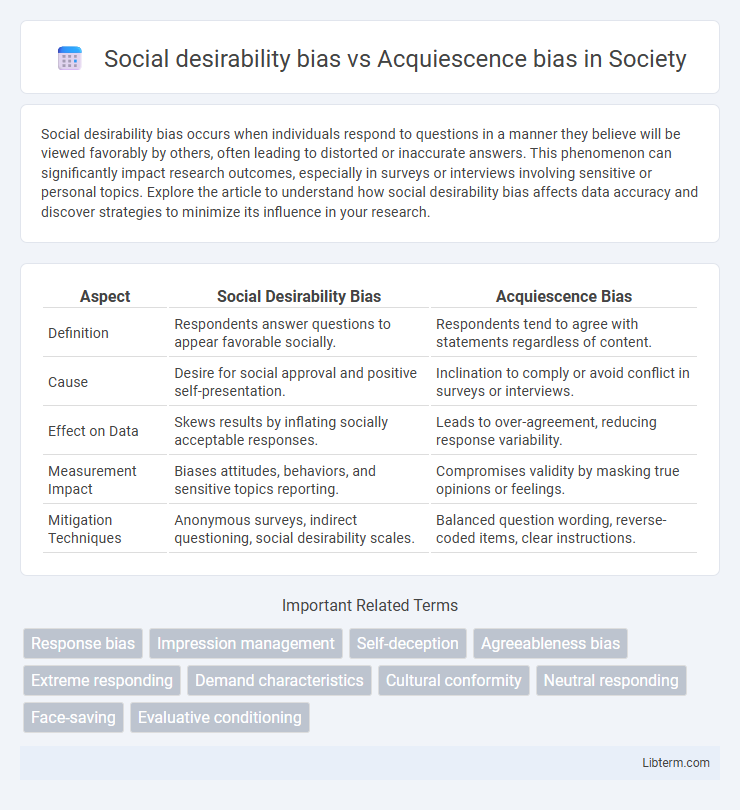Social desirability bias occurs when individuals respond to questions in a manner they believe will be viewed favorably by others, often leading to distorted or inaccurate answers. This phenomenon can significantly impact research outcomes, especially in surveys or interviews involving sensitive or personal topics. Explore the article to understand how social desirability bias affects data accuracy and discover strategies to minimize its influence in your research.
Table of Comparison
| Aspect | Social Desirability Bias | Acquiescence Bias |
|---|---|---|
| Definition | Respondents answer questions to appear favorable socially. | Respondents tend to agree with statements regardless of content. |
| Cause | Desire for social approval and positive self-presentation. | Inclination to comply or avoid conflict in surveys or interviews. |
| Effect on Data | Skews results by inflating socially acceptable responses. | Leads to over-agreement, reducing response variability. |
| Measurement Impact | Biases attitudes, behaviors, and sensitive topics reporting. | Compromises validity by masking true opinions or feelings. |
| Mitigation Techniques | Anonymous surveys, indirect questioning, social desirability scales. | Balanced question wording, reverse-coded items, clear instructions. |
Understanding Social Desirability Bias
Social desirability bias occurs when respondents answer questions in a manner they believe will be viewed favorably by others, leading to overreporting of socially approved behaviors and underreporting of undesirable ones. This bias compromises the accuracy of survey data by distorting truthful responses, especially in sensitive topics like mental health, substance use, or socially stigmatized behaviors. Understanding social desirability bias is crucial for designing effective survey instruments that minimize response distortion through techniques such as anonymous surveys, indirect questioning, and validity scales.
Defining Acquiescence Bias
Acquiescence bias, also known as yea-saying, is the tendency of respondents to agree with statements regardless of their content, often skewing survey or research data. This bias differs from social desirability bias, where participants respond in ways they believe are socially acceptable or favorable. Identifying and controlling acquiescence bias is essential in designing questionnaires to ensure accurate representation of true opinions and behaviors.
Key Differences Between the Two Biases
Social desirability bias occurs when respondents answer questions in a manner they believe will be viewed favorably by others, often leading to overreporting positive behaviors or underreporting negative ones. Acquiescence bias involves the tendency of respondents to agree with statements regardless of their content, resulting in artificially inflated agreement levels. The key difference lies in the motivation behind the response: social desirability bias is driven by the desire to conform to social norms, while acquiescence bias stems from a general agreement tendency or lack of engagement.
Psychological Roots of Response Biases
Social desirability bias stems from an individual's need to be viewed favorably by others, influenced by social norms and the desire for social approval, which drives respondents to alter their answers to align with perceived expectations. Acquiescence bias originates from a psychological tendency toward agreeableness and compliance, often linked to cognitive laziness or a respondent's inclination to avoid conflict or cognitive effort. Both biases are rooted in underlying motivational and cognitive processes that shape how individuals respond under social and psychological pressures during surveys or interviews.
How Social Desirability Influences Survey Results
Social desirability bias significantly skews survey results by causing respondents to answer questions in a manner they believe will be viewed favorably by others, rather than providing truthful responses. This bias frequently leads to underreporting of undesirable behaviors and overreporting of positive actions, thus compromising data accuracy. Compared to acquiescence bias, which involves respondents' tendency to agree with statements regardless of content, social desirability bias specifically distorts results by aligning responses with perceived social norms and expectations.
The Role of Acquiescence in Questionnaire Responses
Acquiescence bias significantly influences questionnaire responses by causing respondents to agree with statements regardless of their true opinions, thereby skewing data validity. This response style can mask genuine attitudes, leading to inflated positive endorsement rates and reduced variability in answers. Understanding and adjusting for acquiescence bias is crucial for accurate interpretation of survey results and improving the reliability of psychometric assessments.
Impact of Biases on Research Validity
Social desirability bias skews research validity by causing participants to respond in ways they believe are socially acceptable rather than truthful, leading to inaccurate data. Acquiescence bias impacts validity by prompting individuals to agree with statements regardless of their true opinions, thus distorting survey results. Both biases reduce the reliability of findings and necessitate the implementation of robust questionnaire design and data interpretation techniques to mitigate their effects.
Strategies to Minimize Social Desirability Bias
Social desirability bias can be minimized by ensuring respondent anonymity and emphasizing confidentiality to encourage honest answers. Utilizing indirect questioning techniques and neutral wording helps reduce pressure to conform to social norms. Implementing self-administered surveys instead of face-to-face interviews decreases the likelihood of socially desirable responses.
Techniques to Reduce Acquiescence Bias
Techniques to reduce acquiescence bias include using balanced scales with both positively and negatively worded items to encourage careful responses and minimize automatic agreement. Implementing forced-choice formats can compel respondents to choose between equally attractive or unattractive options, reducing the tendency to agree indiscriminately. Ensuring anonymity and emphasizing the importance of honest answers also helps mitigate acquiescence bias by reducing social pressure and response conformity.
Best Practices for Mitigating Response Biases in Surveys
To mitigate social desirability bias, use anonymous surveys and indirect questioning techniques, which encourage honest responses by reducing respondent pressure to conform to social norms. Combat acquiescence bias by balancing the questionnaire with both positively and negatively worded items, ensuring respondents critically evaluate each statement rather than uniformly agreeing. Employing randomized question order and implementing validity checks further enhances data reliability by detecting and controlling for patterned or socially driven responses.
Social desirability bias Infographic

 libterm.com
libterm.com